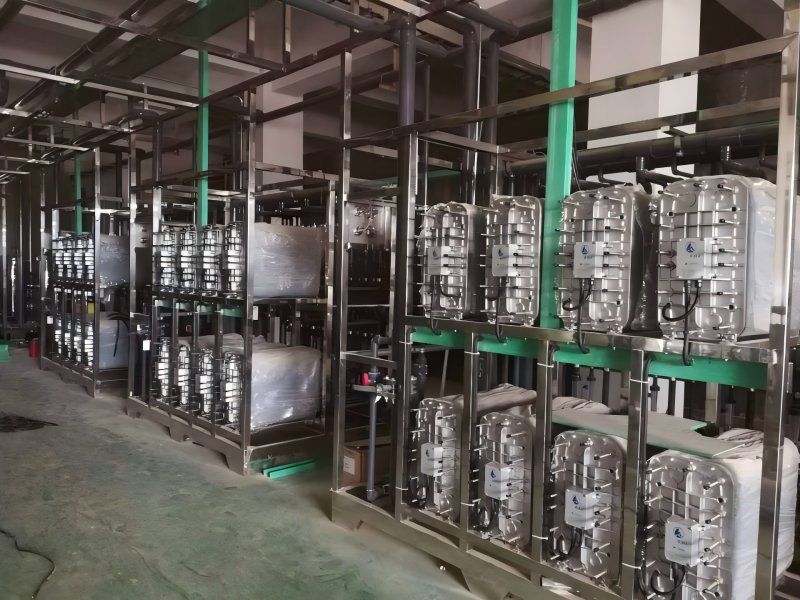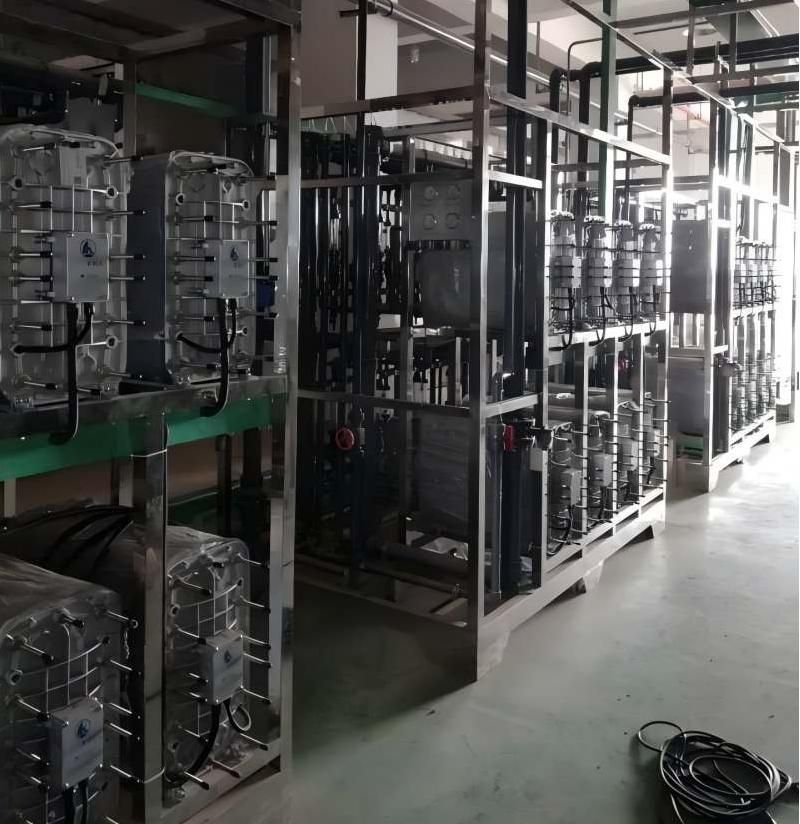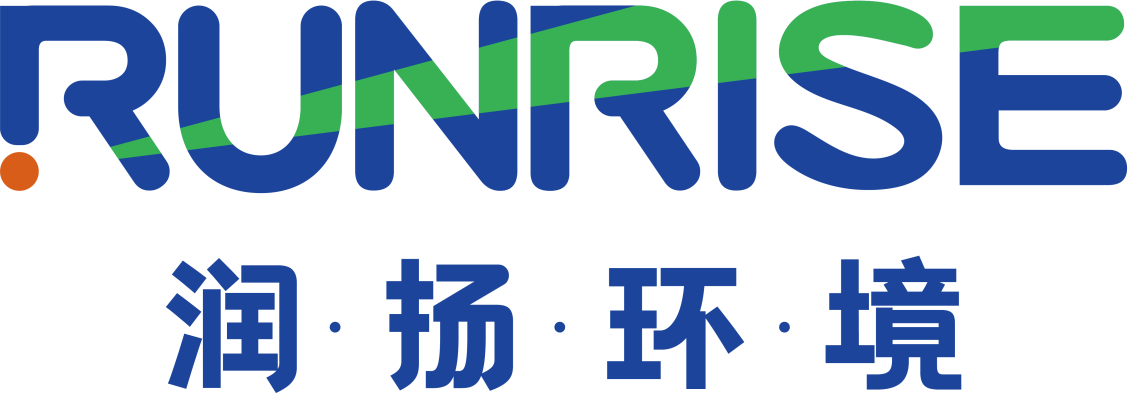Marketing Hotline:
(+86)0532-88988868
(+86)0532-88988868
1. EDI description
EDI technology is a new water purification technology that has gradually emerged since the 80s of the twentieth century. Since 2000, it has occupied a significant portion of the market for ultrapure water equipment in North America and Europe. The EDI system replaces the traditional DI hybrid resin bed to produce deionized water. Unlike ion exchange, EDI does not shut down due to resin replenishment or chemical regeneration. Therefore, EDI stabilizes water quality. At the same time, it also minimizes equipment investment and operating expenses.

EDI is usually combined with reverse osmosis and other water purification devices to remove ions from the water, and EDI modules can continuously produce ultrapure water with a resistivity of up to 18.2MΩcm. EDI can be operated continuously or intermittently.
2. Advantages of EDI
Advantages of EDI over traditional ion exchange (DI):
● EDI does not require chemical regeneration
● No downtime is required for EDI regeneration
● Provides stable water quality
● Low energy consumption
● Low operating costs
3. Electrodesalination process
EDI technology combines two already mature water purification technologies, electrodialysis and ion exchange, through which dissolved salts can be removed under low-energy conditions without chemical regeneration and produce high-quality desalination water.
EDI desalination is to make ions flow from fresh water to adjacent freshwater under the action of voltage. EDI differs from electrodialysis in that it fills a freshwater chamber with resin, and the presence of resin can greatly increase the rate of ion migration. Here, the resin acts as a conductor of ions rather than an ion exchange source, and its working state is continuous and stable.
4. Overview of EDI technology
Electrodesalination fills the ion exchange resin between the anion and cation exchange membranes to form an EDI unit, and then sets cathode and cathode electrodes on both sides of the unit, and further removes ions from its feed water (usually reverse osmosis pure water) under the action of direct current.
Ion exchange membranes and ion exchange resins work similarly and can migrate specific ions. The anion exchange membrane only allows anions to pass through, but not cations. The catholicis only allow cations to pass through, not anions.
A certain number of EDI units are arranged together in the EDI assembly, so that the anion exchange membrane and the cation exchange membrane are arranged alternately. Each EDI unit is separated using a mesh to form a concentrated water chamber. The EDI unit is a freshwater room in the middle. Under the impetus of a given direct current, the feed water is removed through the ion exchange membrane through the ion exchange membrane and becomes desalination water through the freshwater chamber. The ions are carried out of the system through concentrated water, becoming concentrated water.
The EDI component divides the water into three separate streams:
(1) Pure water (maximum utilization rate of 99%)
(2) Concentrated water (5-10%, can be used for RO feed water)
(3) Pole water (1%, discharge)
The polar water flows into the cathode water through the anode first, and the chlorine, oxygen and hydrogen gases produced by electrolysis can be removed from the electrode area.
5. EDI process details
Generally, there are solubilities such as sodium, calcium, magnesium, chloride, nitrate, bicarbonate, silica and other dissolved substances in urban water sources. This compound is composed of a negatively charged anion and a positively charged cation. With reverse osmosis (RO) treatment, more than 98% of ions can be removed. In addition, the raw water may also contain other trace elements, dissolved gases (e.g. CO2) and some weak electrolytes (e.g. boron, silica), which must also be removed in industrial desalination.
The general range of resistivity of RO pure water (EDI feedwater) is 0.05-0.25 MΩcm, that is, the range of conductivity is 20-4ЦS/cm. Depending on the application, the resistivity of deionized water generally ranges from 2-18.2MΩcm.
EDI desalination process. Ions in water and hydroxide ions or hydrogen ions in ion exchange resins are exchanged, and these ions are then migrated into concentrated water. This is the EDI desalination process.
The above exchange reactions occur in the freshwater chamber of the module, where anions (e.g., Cl- in chloride) are exchanged in the hydroxide ion (OH-) in the anion exchange resin. In contrast, cationation exchanges hydrogen ions (H+) in resins with cations in water (e.g., sodium and Na+).
The exchanged ions migrate along the surface of the resin sphere under the action of direct current and enter the concentrated water chamber through the ion exchange membrane.
Negatively charged anions (e.g., OH-, Cl-) are attracted to the anode (+). These ions pass through the negative membrane and enter the adjacent concentrated water chamber, while the adjacent positive membrane does not allow them to pass through, and these ions are blocked in the concentrated water. Cations (such as Na+ and H+) in the freshwater stream are attracted by the cathode and enter the adjacent concentrated water through the cation exchange membrane, which does not allow them to pass through, and these ions are blocked in the concentrated water.

In concentrated water, ions from both directions maintain electrocharged neutrality. At the same time, the amount of current is directly proportional to the amount of ion migration. The flow of electricity consists of two parts, one of which is due to the migration of the removed ions, and the other part is due to the migration of water itself ionized into H+ and OH-ions.
As the water flows through the freshwater chamber and the concentrated water chamber, the ions gradually enter the adjacent concentrated water chamber from the freshwater chamber and are carried out of the EDI component by the concentrated water.
Under the action of a higher voltage gradient, water will electrolyze to produce a large amount of H+ and OH-. These in-situ H+ and OH- are continuously regenerated by ion exchange resins. Therefore, ion exchange resins in EDI components do not need to be regenerated with chemicals. Therefore, ion exchange resins in EDI components do not require chemical regeneration.
Pretreatment of EDI feedwater is the primary condition for EDI to achieve its best performance and reduce equipment failures. Contaminants in the feedwater can negatively affect the desalination assembly, increasing maintenance and reducing the life of the membrane assembly.
The ion exchange resin in EDI components can be divided into two parts, one part is called the working resin, the other part is called the polishing resin, and the boundary between the two is called the working front. The working resin mainly plays a leading role, while the polishing resin is constantly exchanged and continuously regenerated. The working resin bearer is tasked with removing most of the ions, while the polishing resin is tasked with removing hard-to-remove ions such as weak electrolytes.
For concentrated water, the conductivity in the working resin area is comparable to that of RO pure water, which is relatively low, while in the polishing area, its conductivity increases exponentially. For pure water, the conductivity in the working resin region is comparable to that of RO pure water, and the conductivity is higher due to the conductivity effect of resin. In the polishing area, its conductivity is reduced exponentially. Therefore, in the working resin area, most of the voltage is applied to concentrated water, and the voltage gradient of the pure water chamber is not high, while in the polishing area, part of the voltage is applied to the fresh water area, and its voltage gradient is high, which is conducive to the removal and removal of weak electrolytes. At the same time, the ionization filtration of water here is also high, and the resin is in a high activation state.
6. The effect of pollutants on the desalination effect
Contaminants that have a greater impact on EDI include hardness (calcium. magnesium), organic matter, solid suspensions, variable valence metal ions (iron), oxidants (chlorine, ozone), and carbon dioxide (CO2).
Chlorine and ozone oxidize ion exchange resins and ion exchange membranes, causing EDI components to become less functional. Oxidation also increases TOC content significantly. Oxidation by-products can contaminate ion exchange resins and membranes, reducing ion migration. In addition, oxidation causes the resin to crack and the pressure loss through the components will increase.
Iron and other variable valence metal ions can catalyze the oxidation of resins, permanently degrading resin and membrane properties.
Hardness can cause scaling in reverse osmosis and EDI units. Scaling generally occurs on the surface of the concentrated water chamber membrane, where the PH value is high. At this time, the pressure difference between the concentrated water entering and outleting water increases, and the current flow decreases. EDI components are designed to avoid fouling. However, reducing the hardness of the water to a minimum will extend the clear cycle.
Suspended solids and colloids can cause contamination and jamming of membranes and resins, and blocking of resin gaps leads to increased pressure loss in EDI components.
The agent is attracted to the surface of the resin and membrane, causing it to become contaminated, so that the efficiency of the contaminated membrane and resin migration ions decreases, and the membrane stack resistance will increase.
CO2 has two effects. First, CO32 forms carbonate scale with Ca2+ and Mg2+, which is related to the ion concentration and PH of the feed water. Secondly, because the charge change of CO2 is related to the PH value, it is removed by other RO and EDI.


